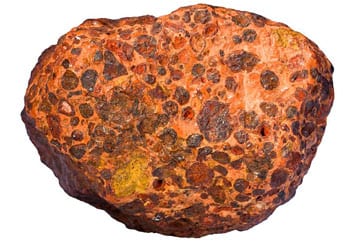Roghnaigh Teanga:
Is alúmanam an eilimint miotail is coitianta a fhaightear ar an Domhan, totaling about 8% de screamh an Domhain. ach, aluminum as an element is reactive and therefore does not occur naturally – it needs to be refined to produce aluminum metal. Is é an t-ábhar ag tosú phríomhfhreagracht maidir le scagadh alúmanam Báicsít, an domhain phríomhfhoinse tráchtála de alúmanam. Bauxite is a sedimentary rock, and consists mostly of the aluminium minerals gibbsite (Al(OH)3), boehmite (c-ALO(OH)) agus diaspore (a-ALO(OH)), and is usually mixed with the two iron oxides goethite and hematite, the aluminium clay mineral kaolinite and small amounts of anatase (TiO2) and/or ilmenite (FeTiO3).

Tá taiscí Báicsít leathadh ar fud an domhain, den chuid is mó a tharlaíonn i réigiúin trópaiceacha nó fothrópaiceacha. Although proven reserves of bauxite are expected to last for many years, Tá an caighdeán na cúlchistí ar féidir rochtain heacnamaíoch laghdú. Maidir le refiners, who are in the business of bauxite processing to make alumina, agus miotail sa deireadh alúmanam, tá sé seo dúshlán le impleachtaí airgeadais agus comhshaoil araon.
The process to refine metallurgical bauxite into alumina involves the following inputs:
The following outputs are generated:

The most widely used chemical process of refining bauxite into alumina, próiseas Bayer, involves dissolving the Al2O3 out of the bauxite rock with caustic soda (NaOH) at elevated temperature and pressure. The Al2O3 fraction of the bauxite is dissolved into solution, to later be precipitated out as alumina. ach, a high-grade bauxite contains up to 60% Al2O3, and many operating bauxite deposits are well below this, ó am go chéile chomh híseal agus is 30-40% Al2O3. Because the desired product is a high purity Al2O3, na hocsaídí atá fágtha sa Báicsít (Fe2O3, SiO2, TiO2, Organic material) are separated from the Al2O3 and rejected as alumina refinery resides (ARR) or red mud. Go ginearálta, an caighdeán níos ísle ar an Báicsít (ie lower Al2O3 content) the more red mud is generated per ton of alumina product. Freisin, even some Al2O3 bearing minerals, go háirithe kaolinite, produce un-desirable side reactions during the refining process and lead to an increase in red mud generation, chomh maith le caillteanas de daor ceimiceach sóid loiscneach, costas athróg mór sa phróiseas scagtha Báicsít.
Is ionann láib dearg nó ARR mór agus leanúnach dúshlán don tionscal alúmanaim. Tá láib dearg leftover suntasach loiscneach iarmharach cheimiceacha ó phróiseas scagtha, agus tá sé an-alcaileach, go minic le pH de 10 - 13. It is generated in large volumes worldwide – according to the USGS, Bhí measta táirgeadh alúmana domhanda 121 milliún tonna i 2016. This likely resulted in more than 150 milliún tonna de láib dearg ghintear le linn na tréimhse céanna. In ainneoin taighde leanúnach, Tá cúpla cosáin inmharthana ó thaobh tráchtála go tairbhiúil athúsáid láib dearg faoi láthair. Tá sé measta go bhfuil an-beag de láib dearg is tairbhiúil ath-úsáidtear ar fud an domhain. Instead the red mud is pumped from the alumina refinery into storage impoundments or landfills, áit a bhfuil sé stóráil agus déanfar monatóireacht ar chostas mór.
An caillteanas de sóid loiscneach daor (NaOH) and the generation of red mud are both related to the quality of the bauxite used in the refining process. Go ginearálta, the lower the Al2O3 content of the bauxite, an níos mó an líon na n-láib dearg go mbeidh a ghiniúint, as the non-Al2O3 phases are rejected as red mud. Freisin, the higher the kaolinite or reactive silica content of the bauxite, Beidh an láib níos dearg a ghiniúint. The reactive silica content not only increases the volume of red mud, but also consumes caustic soda reagent and reduces the yield of Al2O3 recovered from the bauxite. Mar sin, there is both an economic and environmental argument to be made for improving the quality of bauxite prior to refining.
Tugann an próiseas STET scaradh tirim Báicsít táirgeoirí nó na scagairí Báicsít deis a dhéanamh uasghrádú réamh-Bayer-próiseas méine Báicsít chun caighdeán. Tá an cur chuige seo go leor buntáistí:
Go hachomair, próiseáil tirim leis na deiseanna tairiscintí deighilteoir STET chun luach do tháirgeoirí Báicsít agus scagairí a ghiniúint. Beidh an réamh-phróiseáil bauxite roimh scagadh laghdú costais ceimiceacha, níos ísle ar an líon na n-láib dearg ghintear agus eagrais próisis a íoslaghdú.
tagairtí: